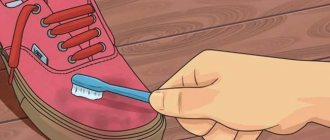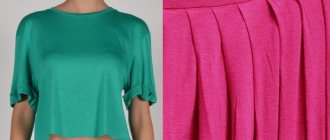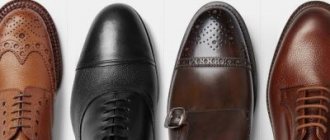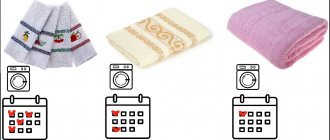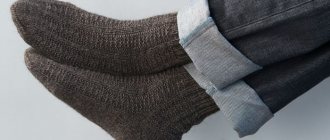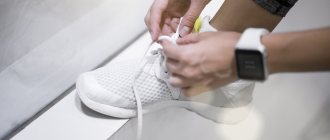Proper laundry washing begins with sorting. In addition, washing clothes, sneakers and down jackets require different detergents. You also need to select the appropriate washing function and temperature. Afterwards, dry the laundry, following all individual recommendations for washed items. High-quality washing depends not only on the washing machine, so you need to understand each issue in more detail.
Rules for washing things in a washing machine
Often the result of washing in a machine does not satisfy the user for a simple reason - the items were not separated by color and type of fabric. Sort your laundry correctly before loading it into the drum. Ideally, to obtain good quality washing, items should be sorted strictly by:
- color;
- material;
- size;
- degree of pollution.
In practice, it is not always possible to clearly separate things by characteristics, so some of them with similar parameters can be combined.
Before loading clothes into the drum, be sure to check the pockets. Remove all contents from them, shake out any crumbs and small debris so that they do not end up in the washing machine.
If the pocket has a clasp, do not close it so that air bubbles do not form. On the clothes themselves, it is better to fasten the zippers and buttons, if there are buttons instead of buttons, there is no need to fasten them.
When washing pants, it is correct to turn them inside out, and straighten the sleeves of shirts. Before washing, it is necessary to check the reliability of fastening of clothing items. It is better to remove buttons that are barely holding on so that they do not fall off during washing. If possible, clothing should be freed from:
- brooches;
- belts, belts;
- laces, garters and other elements.
Before putting bed linen in the washing machine, you need to turn it out and shake it, especially if you have feather pillows. Also, before washing, it is more correct to turn items made from terry fabrics and knitwear inside out. Belts, socks, underwear, small scarves should be placed in the washing machine drum in a washing bag.
Loading items into the washing machine must strictly follow the equipment manufacturer’s instructions. Follow the recommended volume of laundry and distribute it evenly throughout the drum.
Using an eye and following simple rules, you can do without weighing things. Just compare the volume of dry laundry to the volume of the drum. You can completely load the washing machine with cotton items, but you don’t need to compact them. It is permissible to load the drum halfway with synthetic fabric, and one-third with wool items.
Don't let one item get tangled up with another. You should not put laundry that differs significantly in size into the machine at the same time. Thus, washing a large, heavy duvet cover and panties contributes to the imbalance of the machine.
The correct option for washing underwear involves setting it to a delicate cycle. It is better to put bras in the washing machine in a frame bag, which will prevent the “underwires” from getting inside the unit and prevent the straps from being pulled out.
More: Choosing a washing machine class
Where to begin
Experts note that only one percent of people read product care labels. However, if most people paid attention to the manufacturers' instructions, the clothes would look and last much longer.
In Western Europe, it has been calculated that on average each resident throws away up to several tens of kilograms of clothing per year. Why?
Partly due to the fact that it is made from low-quality materials. And partly because a person does not know at what temperature to wash something made of cotton or wool.
How to wash baby and newborn clothes in a washing machine
Among the many problems that arise when a newborn appears in a family, organizing the correct and safe washing of the baby’s clothes is not the least important. After all, modern detergents, capable of removing the most difficult stains, making clothes snow-white, and things pleasant to the body, often contain chemicals that are not safe for the health of an adult, and even more so for a baby.
What mode should I wash on?
Machine washable allows you to wash your items well. But if there are stains on them, it is necessary to wash the children's clothes first.
The washing regime for a child’s clothes should take into account his age. For newborns, you should choose "Children's clothing". If it is absent, use a mode in accordance with the type of fabric, and a sufficiently high temperature.
For diapers and vests, the temperature should be high – about +90ºС. Washing clothes for older children who are already learning to walk - in accordance with the instructions on the product labels.
Procedure for washing clothes for children:
- Clean things from dirt (feces, traces of belching).
- Fasten buttons, Velcro and snaps on the clothing that will be placed in the drum.
- Place baby clothes in the washing machine.
- Pour baby powder or appropriate washing gel into the detergent compartment.
- Set the “Children's clothing” mode. If it is not there, then select the appropriate type of material.
- Set the water heating temperature.
- Set up an additional rinse.
- After finishing washing, hang the clothes to dry.
- Additional rinsing allows you to remove detergent residues from the fabric fibers as best as possible.
Rules for using detergents for children's laundry
The baby's clothes and bedding must be processed separately from the belongings of adult family members.
Dirty rompers, diapers and sheets should be put in order within 24 hours so that pathogenic bacteria do not multiply in them and the fabric does not deteriorate from ingrained substances.
It is better to first scrub soiled diapers and panties by hand in cool water, and then put them in the machine.
The drum of the machine should not be packed tightly - this reduces the cleaning efficiency.
At what temperature should you wash children’s clothes: bed linen and underwear – at 90–95°C in order to thoroughly disinfect it; other clothes - from 30 to 60 ° C (depending on the manufacturer’s recommendations).
It is necessary to include an additional rinse to remove as much residue as possible, even if you use hypoallergenic washing powders that are safe for children.
At the end of the procedure, it is worth using conditioner - it makes things soft and protects them from the formation of pills, and also provides an antistatic effect.
When washing by hand, bedding and underwear should be boiled, other clothes should be soaked in water at a temperature of 40–50°C.
What's the best way to wash a newborn's clothes?
Which product is effective and safe for a baby? Every mother asks herself this question, because the baby’s health will depend on the right choice. The baby's protective skin barrier is quite weak, so various substances that provoke the development of allergies, as a rule, penetrate through it.
In addition, household chemicals contain volatile substances that can cause a respiratory allergic reaction in the baby, weakening the immune system. Before purchasing a detergent, you need to study the composition and read reviews on the Internet.
Pediatricians recommend washing a newborn's clothes with special soap. It preserves the structure of tissues, making them softer. For this purpose, you can use laundry soap that does not contain fragrances. However, it is only suitable for hand washing and requires careful study of the composition.
You cannot wash a newborn’s clothes with the addition of conditioners and rinse aids. As a rule, they are distinguished by a pungent odor that irritates the baby’s mucous membrane. If there are stains on the product, you can try to remove them with hydrogen peroxide.
You can only wash your newborn's clothes with bleach if:
- the product does not contain chlorine or other aggressive components;
- After washing, the product is thoroughly rinsed.
However, even with an absolutely safe composition, it is impossible to predict what reaction bleach will cause from the child’s body. In addition, repeated rinsing cannot completely remove particles of the product from the fibers of things.
Membrane overalls for newborns are washed with specially designed products. They help preserve the original properties of the membrane and extend its service life.
At what temperature should you wash baby clothes?
Often a young mother is faced with the question of what temperature to wash children's clothes at. There is nothing complicated about this: look at the tag on the clothes; the recommended temperature conditions are indicated there. Often, parents try to buy underwear and clothes made from thick cotton fabric for their baby.
This material can be washed at 90 degrees. But do not forget that high temperature conditions can ruin colored things - they will not only lose their brightness, but also “fading”. To prevent this from happening, we recommend washing overalls, rompers, vests and other items at 40 degrees. And set a higher degree only if the laundry is very dirty and covered with serious stains.
Washing frequency
Well-known rules: change bed linen at least once a week, underwear - daily. It is better not to accumulate dirty things, so that stains from being easily washed do not turn into difficult to remove. But you shouldn’t “torment” things with prolonged washing either. Excessive mechanical load will affect the appearance of the product and its durability. If the dirt is minor, you can wash it in express mode. An additional rinse will remove detergent residue from the fibers. This is true for children's clothing and those adults who suffer from skin allergic reactions.
What mode should I use to wash bed linen?
Before washing machines began to appear in every housewife’s home, things were washed in hot water, often even boiled. After this, disinfection was usually carried out. Today there is no need to spend so much time and effort.
An automatic washing machine will easily complete the task if you know at what temperature you need to wash bed linen and what products to use for this. How to wash bed linen made from light cotton or linen?
Optimally at 60 degrees - this program will be enough for high-quality and effective washing. For better disinfection, don't be afraid to set higher temperatures. But you should know that this will wear out the item faster.
At what temperature should I wash bed linens with bright colors? Set the temperature to 30-50 degrees. When washing, use products specifically designed for colored fabrics. For example, liquid shampoos are perfect. If it is covered with small stains, pre-soak it for several hours or spin it in the washing machine on the pre-wash cycle.
The washing temperature of the bedding on which your child sleeps can be 60-90 degrees. You learned how many degrees to wash bed linen so as not to damage the fabric or deprive it of its attractiveness. You can also share recommendations about washing powders and air conditioners with your loved ones and friends - they will find it useful.
More: Choosing a washing machine based on the material of the tank
How to dry clothes
Immediately remove washed laundry from the machine. It is best to hang it outdoors - this will further freshen things up. Shake your clothes and hang them as evenly as possible without having to iron them. Dresses and shirts made of thick fabric can be dried on hangers. This way they are less deformed and wrinkled. Knitted items are dried on a horizontal surface. Lay them out on a clean towel and shape them into the correct shape.
To save time, you can purchase a dryer or washing machine with a drying function. It is convenient to dry bulky home textiles - bed linen and towels. Machine drying further softens the fabric and makes towels soft and fluffy even without conditioner.
What mode should I use to wash jeans?
Despite the fact that manufacturers recommend washing jeans clothes by hand so as not to spoil the appearance, you can wash jeans in an automatic washing machine, regardless of the model of the washing machine, be it a Samsung or Electrolux washing machine or any other modern washing machine
You just need to do this correctly, taking into account the features of the decor and the type of fabric from which they are made. Before washing, jeans should be treated to remove all types of stains.
If stains have appeared on the fabric recently, then ordinary washing powder will cope with them without any difficulty. And if the dirt has become embedded in the fabric or has already dried out, then you can use salt and ammonia. Or use industrial stain removers such as “Vanish”, “Antipyatin”. Before washing in the washing machine, you need to fasten all the locks, buttons and buttons on the product.
First of all, you need to select:
- the desired water temperature (no more than 30 degrees);
- optimal washing mode;
- high-quality detergent (for colored items or a special detergent for washing denim items);
- correct spin mode (no more than 800 rpm).
Selecting a mode for washing denim items
So what mode should you use to wash jeans? The modes of modern washing machines are adapted for washing different types of fabrics, including denim - the “Jeans” mode. The mode can be adjusted manually, based on the recommendations indicated on the clothing label.
The following modes are recommended: Hand wash – gently washes denim at low speed. Delicate – recommended for washing jeans decorated, for example, with lace or sequins.
Washing occurs at a temperature of 30-40 degrees at low spin speeds. Express - used to refresh clothes. You can wash jeans using this mode if the stains on them are not very persistent.
Washing, spinning and energy consumption classes
To designate them, special signs are used - letters of the Latin alphabet from A to G. The farther from the beginning, the worse the quality and the lower the rating: A - “excellent”, B - “very good”, C - “good”, D - “satisfactory” " and so on.
Wash
To determine which class to assign to a particular model of equipment, simple tests are done. Cotton fabric is washed in a testing machine for an hour at a water temperature of 60°C. The result is compared with the sample and conclusions are drawn.
What does it mean to you to wash an item perfectly? Remove all the dirt from it, right? The difference in the quality of washed clothes between the so-called grade A and B is so small that not every consumer will see it. Therefore, it cannot be categorically stated that a machine with a B rating is much worse at washing. Class C machines are washed with a weak “four” rating, but they are cheaper.
In modern automatic washing machines, the spin range is from 400 to 2000 rpm. The class directly depends on the number of drum revolutions during this function. The higher the speed, the higher the class and the less moisture in the laundry. But it is not always possible to apply maximum twisting for equipment with an A rating, you have to purchase special devices so that they do not “jump” during operation.
Energy consumption
The less electricity a machine uses, the higher its rating. Until 2002, there were seven classes. Now the economical class A (energy consumption 0.17-0.19 kWh/kg) has been supplemented by the more economical class A (0.15-0.17 kWh/kg) and A (less than 0.15 kWh/kg). Models with a rating of B (up to 0.23 kWh/kg) can operate when the TV or other office equipment is turned on. But cars with a rating of C (up to 0.27 kWh/kg) are now considered obsolete (other categories are not even worth mentioning!).
We suggest you familiarize yourself with How to remove old wallpaper without extra effort - how to quickly tear off old vinyl wallpaper from walls without extra effort?
How to wash sneakers in a washing machine
Considering that sneakers are sports shoes, they get dirty much faster than shoes, boots, sandals and other products that we wear in everyday life. Consequently, their care should be more thorough and regular.
Which sneakers can be washed and which cannot?
This information will allow you to understand which shoes can be washed in a machine, and which ones are better to clean by hand so as not to risk ruining them.
Let's start with taboo. It is strictly not recommended to wash using household appliances:
- Cheap Chinese products. After the first wash, the sneakers will lose their shape and fall apart, and glue will appear at the joints of the parts, which will be much more difficult to remove than initially cleaning the shoes by hand;
- Models decorated with rhinestones, beads, reflectors and other decorative elements. They can damage the drum or come off and clog the machine, not to mention the permanent loss of the sneakers’ former attractiveness;
- Shoes made of leather and suede or with inserts made of these materials. They are very demanding of care and require careful treatment. Machine washing will completely ruin the appearance of these materials;
- Sneakers with light. It will not withstand washing and will simply stop working;
- Damaged shoes. If the seams have come apart or parts have come unglued, then only manual cleaning is allowed. Machine washing will make the situation even worse.
At the same time, owners can wash sneakers in a washing machine and avoid any negative consequences:
- shoes made of thick fabric;
- running mesh sneakers and their analogues;
- models with cotton top.
Let us note once again that only high-quality shoes can be machine washed. Cheap products come apart, lose their shape, tear, and become covered in glue stains. You need to remember this.
If your machine does not have a shoe washing function, then you will need to set the temperature to no more than forty degrees. Also, the drying and spinning function will need to be completely excluded from the cycle.
The process of preparing shoes before washing
If you are planning to wash your shoes for the first time and do not know how they will react, then the preparation process is mandatory. If the shoes are of low quality, it is still better to clean them manually, since it is possible that after washing they will lose their original appearance. If the quality of the sneakers is normal, then you need to start the preparation process.
First, the insoles are removed. It is recommended to wash them separately by hand, but you can also wash them together with the sneakers in a washing machine. However, the hand washing process is not complicated. The insoles are rinsed with warm water and sprinkled with powder. After a few minutes, lightly clean it with a shoe brush, rinse and leave to dry.
The sole is the dirtiest place where various pebbles, chewing gum, etc. collect. You will need to clean it with knitting needles, otherwise these inclusions can have a very negative impact on the operation of the machine in the future. After the sole is cleaned, you need to rinse it under running water.
It is also recommended to use a specialized laundry bag. In it, the shoes mainly retain their original appearance. If you don’t have a bag, you can throw a few old towels into the washing machine. They will prevent shoes from knocking on the drum, and this in turn will preserve the shape of the product and prevent the drum from breaking.
How to properly wash suede sneakers and shoes made of synthetic materials
- Determine whether a particular shoe can be machine washed according to the manufacturer's recommendations;
- Carry out the initial sole cleaning process;
- Remove the insoles and soak them;
- Place the shoes in the bag;
- Load into the machine and begin the wash cycle.
During the washing process, we exclude the options of spinning and drying. The listed processes can become the basis for rapid damage to your shoes. You should also dry your sneakers properly after washing. It is recommended to pour a standard portion of powder into the washing machine dispenser. The washing temperature does not exceed forty degrees. For white sneakers, you can add chlorine-free bleach, this will give an excellent result.
What program should I use to wash sneakers?
Some machines have a special shoe washing mode. In the absence of one, you should use the delicate mode. You should not set the water heating above 30 ℃ - staying in hot water leads to deformation of shoes and discoloration of materials.
Do not use the automatic spin function when washing sneakers - even the highest quality models may not withstand the load when the drum rotates at high speeds.
Since hot air is dangerous for shoes, it is better to avoid using the drying mode. As for the powder, or better yet the liquid detergent, follow the standard recommendations: add the same amount of detergent as for regular washing.
We select and configure the program
It is important to remember that if you run a non-delicate wash, even the strongest and most reliable sports shoes from famous clothing manufacturers will not withstand it. For this reason, all necessary parameters in an automatic machine are manually configured by the user. The water temperature should be no more than 40 degrees; experts even recommend not to exceed 30 degrees.
It is necessary to set the “no spin” mode. It is better if the wash lasts no more than half an hour. When sneakers are in water for a longer time, this does not have the best effect on the fixing materials and leads to damage to the product.
Bosch washing machines do not have a separate mode for cleaning sports accessories, so it is worth using functions such as “Super quick wash”, “Short wash”, etc.
All of these modes are ideal for cleaning sneakers, but it is important to remember that the program automatically includes a spin phase, which must be removed manually before starting the household appliances. If this is not possible, spinning should be done at minimum speed.
Selecting the optimal mode for different types of fabric
You should dry-clean tough clothes that may lose their shape - hats, wedding dresses, corsets. Do not wash fabrics contaminated with flammable liquids (kerosene, gasoline). The substance may corrode machine parts. Such laundry should first be rinsed and dried. It is recommended to wash by hand:
- shirts with stiff collars;
- leather goods and shoes;
- curtains;
- thermal underwear;
- wool sweaters;
- tulle;
- sneakers;
- underwear;
- things of newborns.
Fabrics that do not like machine washing:
- biofluff;
- padding polyester;
- fluff;
- feather;
- polyester;
- fleece;
- mohair items;
- membrane tissues.
If dye has been spilled on clothes or a child has soiled the item so that it seems hopelessly damaged, with the right choice of washing mode and cleaning products, you can get rid of any contamination. It is important to pay attention to the signs indicated on the label and follow the instructions. Due to unsuitable items, the settings of the washing machine may be lost and clothes may be damaged.
Article verified
by the editors
Both cotton and linen items are washed separately from other types of fabric. They wash almost identically. You can load up to 6 kg of dry laundry into the drum, depending on the model. White items can be washed at temperatures up to 95°C, colored items – 40°C. The spin can be set at 1400 rpm, for denim - up to 800 rpm. To wash them optimally, you need to set the maximum time.
To clean synthetic fabric items, load no more than three kg into the drum and wash on a gentle cycle at 30°C. Synthetic fibers quickly release dirt, so there is no need to torture this material for a long time. Unscrew at 600 rpm.
One load of wool should not exceed two kilograms of dry laundry. Wash at 30°C, choose delicate or manual mode. Use special covers. The optimal number of revolutions is 1200.
If you need pure silk products, then one bookmark should weigh no more than 1 kg. Select delicate mode at 30°C. Remember that silk is a very delicate material, so rubbing it and washing it for a long time is not recommended. You need to unscrew at 400 rpm. Use the same functions for viscose products. Do not dry!
How to wash a down jacket in a washing machine
The easiest way to wash a down jacket at home is to wash it in an automatic machine. Unlike hand washing, an automatic machine takes care of the main problem, that is, rinsing.
Step by step guide
- Treat the most contaminated areas with laundry soap.
- Load one down jacket into the drum. Do not wash multiple outerwear items together.
- It is very important what mode you use to wash your down jacket. At what temperature should I wash a down jacket? Turn on the most delicate program, since the water temperature should never exceed 30 degrees.
- Additionally, add 3-4 tennis balls or laundry balls to the drum. During cleaning, they will gently hit the surface of the product, fluffing it up. Both the natural filler and the synthetic down of your down jackets will not form lumps. In addition, the balls increase the effectiveness of the detergent and allow you to wash difficult stains. This little secret to washing at home will help you achieve the same results as professional cleaning.
- Now you need to add detergent to the automatic machine. Please note that the recommended amount must be reduced by ¼. This is exactly how much powder is needed to wash the product.
- After the wash cycle is completed, turn on the second rinse. This will help remove any remaining foam from the down jacket. In addition, rinsing with special balls will fluff up the product. As a result, it will become softer and warmer.
- Once the wash is finished, remove the item from the drum and begin drying it.
Fabric softener
The compartment marked with the image of a flower, the letter C or the numbers 3 and III is intended for the air conditioner. This liquid makes laundry softer and prevents soiling. Even if a stain appears on the fabric, it will wash off much easier. Clothes washed with conditioner are easier to iron and have a pleasant aroma.
However, some items are best washed without conditioner. It may cause streaks to appear on silk, shapewear may lose its elasticity, and outerwear may lose its water-repellent properties.
The conditioner must be poured according to the instructions. A small amount of conditioner will not have a softening effect, and a large amount will make the fabric unpleasant to the touch.
Why does the washing machine get dirty?
Often the housewife herself forgets iron coins or other things in the pockets of clothes intended for cleaning. Small objects get stuck in the cuff and centrifuge, rust, and during the next wash the machine stains things with brown spots. In such a situation, it is enough to free the drum from foreign objects, clean the filter, and the problem will be solved.
The appearance of stains after washing can occur for the following reasons:
- Worn seal or bearing. Oil seal is a gasket that protects the bearing from water ingress. For better sliding, the oil seal is treated with machine oil. Over time, the gasket wears out, the lubricating fluid penetrates the water and leaves oily gray and yellow stains on clothing. When a machine operates with such a malfunction, noise and grinding noises are heard.
- Dirt in the cuff. If you do not regularly care for your washing machine, dirt accumulates in the rubber cuff located between the body and the drum. During the washing process, plaque particles enter the water and can stain the laundry.
- Mold on the drum and tray. The right environment for mold to form is damp and warm. If, after finishing work, you do not dry the washing machine, but immediately close it tightly, then such a favorable atmosphere is created inside the unit. You can find out about accumulated black mold by the appearance of dark spots on clothing and a characteristic unpleasant odor.
- Rusty water. After repairing the water supply, dirty water with rust comes out of the tap. If the machine runs a cycle on such low-quality water, the washed clothes will be colored with brownish stains.
- Wrong choice of detergent. The quality of the washing powder can be judged by the gray and white spots on clothes. If you come across a fake, it is better to change the detergent. Whitish stains, clearly visible on dark fabrics, may appear due to incorrect dosage of powder and insufficient rinsing. Regular powder cannot be used to wash sportswear made from membrane fabric. There will definitely be white and yellow spots on them.
- Some of the reasons discussed are less common, others more common, but all of them lead to the washing machine dirtying the laundry, and this requires a quick solution. Often it is possible to cope with the problem on your own, and only sometimes you have to involve specialists in repairs.
Problems in the water
A few words about water, which contains huge amounts of iron and which washes our things. It is iron that causes equipment to become stained, deposits to form on parts, and yellow spots to appear on clothes after washing.
Washing in such water can ruin white laundry and give it not only yellow, but also brown stains, which are almost impossible to remove.
At first these may be small specks, but then they become larger and larger. Therefore, before putting the laundry into the machine, you need to open the cold water tap and check whether the water is running clean or rusty with small debris.
After replacing the pipes, it is better not to use the washing machine for a while if you do not want stains to appear after washing. When using water from wells, installing filters may be a solution.
Dirty cuff
If the washing machine is not properly maintained, a thick layer of gray dirt appears in the folds of the hatch cuff, as well as under it. When you touch it, things become smeared and unpleasant marks appear on them. You can clean the cuff using brushes and a cloth. You need to act carefully so as not to damage the rubber. It is not recommended to use
Mold in the tray
If the user does not regularly rinse the cuvette, does not open it after washing to dry and slams the hatch door, this leads to dampness inside the washing machine and, as a result, to the appearance of mold. In addition to contaminating laundry, it can negatively affect human health. You can detect mold by the specific smell inside the washing machine drum.
Mold deposits can be everywhere: in and under the detergent drawer, on the cuff, in the drum, pipes, at the top of the tank walls.
Contaminants in the drain system
A dirty drain filter can also cause mold. In washing machines with a standard drain pump, it spreads an unpleasant odor, and in expensive appliances with a recirculation pump it also leaves stains on the laundry. To avoid this problem, you should clean the drain filter regularly.
You will also need to disassemble the washing machine and rinse the tube connecting the pump to the tank under a powerful stream of water. Dirt also accumulates in it, which is not washed out even when cleaning the device with citric acid or chemicals.
Follow the rules for handling the washing machine - and you will never again have to wonder why dark, light, or both types of stains appear on things after washing them in the machine.
Removing stains
Most questions arise about the correct way to wash in a machine when the laundry is heavily soiled. Indeed, to get a good result, just knowing the automatic machine’s programs is not enough. There are different ways to deal with heavy stains on things.
The stain needs to be worked on before loading. Wash it by hand or use a stain remover. You can remove stains using either dry or liquid stain remover, following their instructions.
If your machine has a pre-wash function, feel free to use it to combat stains. She copes well with the task of doing two washes at once. You just need to pour the powder into two compartments of the cuvette, select the desired mode and turn on the function.
One regular wash, and a second with the addition of bleach, help remove stains from white fabrics. Do not use products containing chlorine; choose oxygen bleach, which will not harm the internal parts of the automatic machine.
What factors determine the duration of washing?
The duration of this process may be affected by:
- The degree of soiling of the laundry . Only machines with artificial intelligence can assess how dirty things are. This will lengthen the washing cycle by 10-15 minutes on average. In simpler models, the owner himself chooses additional functions, such as pre-soaking, additional washing or boiling. This will add up to another half hour to the cycle. Electricity costs will also increase.
- Weight of loaded items . Latest generation washing machines can weigh laundry. The larger the load, the longer the wash cycle.
- Age and other individual characteristics of the washing machine . The older the model, the longer it takes to wash. The newest machines do it faster, and some have a quick wash function that is not inferior in quality to the standard one.
- Heating water . Washing machines are connected to a cold water supply system, so most modes require the water to be heated. This takes from 5 to 15 minutes, depending on the selected temperature.
- Spin speed . The higher the selected number of revolutions, the longer this stage.
The following will help reduce washing time:
- setting a lower water temperature;
- exclusion of additional functions, such as pre-soaking, boiling, additional rinsing;
- skipping some standard steps, such as spinning.
Design of automatic drum-type machines
So, the basis of such machines is a cylinder-shaped drum, which is placed in a tank suspended inside the machine body on springs. The position of the tank/drum unit is controlled by a system of shock absorbers and counterweights. Water is drawn directly into this very tank through a solenoid valve. Its quantity is controlled by a special device called a water level sensor or pressure switch.
The rotation of the drum is ensured by a drive motor and a bearing system. The drive can be belt or “direct” (the motor is directly connected to the shaft of the drum cross). A heating element is placed in the water tank, whose task is to heat the water. To control the water temperature, the heating element is supplemented with a temperature sensor, which is located in the tank body or directly in the heating element itself.
Water is drained from the tank using a special drainage pump. Automation of the process is achieved using an electronic control module, which is the “brain” for the washing machine. The entire operating algorithm completely depends on this element.
Water heating
As soon as the tank of the machine is filled, a special control board activates the heating element, represented by a traditional tubular heating element system. The element increases the temperature of the water until the thermistor signals that heating has stopped.
Thus, three devices are involved in the process of heating water: a control board, a thermistor and a heating element. If at least one of the elements stops working correctly, errors will occur. The water may remain cold for the entire wash cycle or, on the contrary, heat up to very high temperatures or even boil.
How to prepare for washing
Once you start doing laundry, you need to understand the capabilities of your washing machine. Dirty items are placed directly into the drum of the device, after which the door must be closed tightly. The amount of laundry that can be washed at one time depends on the parameters of the specific washing machine and the type of items. One of the main parameters that people rely on when purchasing such equipment is the loading volume, indicated in kilograms. It is worth considering here that the maximum capacity declared by the manufacturer applies to dry laundry.
The washing machine always indicates the maximum weight of laundry it is designed for.
There are also recommendations regarding the type of material:
- When washing delicate fabrics (silk, wool), you should not do a full load - it is recommended to fill the drum no more than a third of the maximum possible level;
- when washing synthetics, the drum is filled 50% (that is, if the maximum permissible load is 5 kg, no more than 2.5 kg of clothes should be placed);
- cotton and linen can be loaded in the full amount specified for the washing machine.
When washing linen and lace, it is necessary to place things in special bags or balls so that the fabric is not damaged.
After the laundry is placed in the drum, you need to pour in the detergent, select the washing program and press the “Start” button.
Device design
Any washing machine consists of the following components:
- Frame. Protects internal equipment elements from damage.
- Drum. A moving part that allows the laundry to rotate during washing.
- Engine. The main force that rotates the drum.
- Tank. A container into which laundry is loaded.
- Pumps. Devices for filling the tank with water and removing excess moisture at the end of washing.
- Power block. Provides energy to the engine and electronic components of the system.
- Electronics. This includes the main control unit, sensors and switches for setting the operating mode of the machine.
Tips and secrets of experienced housewives
It is impossible to fully cover the topic of how to properly wash things in a washing machine without useful tips and a number of tricks.
- It is better to wash adult clothes separately from children's clothes.
- You can check whether the item has faded by wetting a small area with warm water and rubbing it with a white cloth.
- For towels, you can add 2 tablespoons of vinegar to the powder compartment. It will destroy bacteria and eliminate the musty smell inherent in towels.
- Curtains with lace patterns and similar fabrics that require extremely delicate handling can be washed in the washing machine if the volume is significantly underloaded.
- You can add softness to terry towels and bathrobes by additionally rinsing them with a small amount of salt.
- If it is difficult to determine the type of fabric, choose a mode with a low temperature, because if the temperature for the material is higher than permissible, the clothing will shrink significantly.
- When you take the washed items out of the drum, be sure to shake each one so that they are not too wrinkled.
In conclusion, it is worth adding that proper washing of clothes in an automatic machine provides at least three advantages. The equipment will last longer, linen and things will be washed well while maintaining their original appearance, and you will be able to further save time and money through the rational use of resources such as electricity and detergents.
Which washing powder to choose
Today, stores sell a huge number of powders of domestic and foreign production. Which one is better? It all depends on several factors:
- Machine or hand wash. To wash in a machine, choose a product marked “Automatic”. This powder does not form a large amount of foam.
- Gel or powder. Some types of clothing (jackets with a membrane, children's clothes) are best washed with gel. It dissolves faster even in cold water and is easily washed out of the fibers.
- Light or colored items. For bright fabrics, it is better to choose a product marked Color. For best results, add a color protection conditioner.
- How much money do you need? The amount of washing powder or gel depends on the load on the drum, the softness of the water and the composition of the detergent. Usually the dosage for one wash cycle is indicated on the box, and larger packages come with a measuring cap as a gift.



